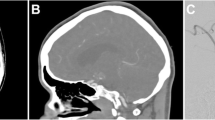Abstract
Spiral CT and magnetic resonance angiography (MRA) were performed in ten patients with 14 intracranial aneurysms known from conventional angiography. All lesions, the smallest 3 mm in diameter, were visible on spiral CT and MRA. The neck of the aneurysm and its anatomical relations could very accurately be determined in all cases. Advantages of spiral CT over MRA are: a short acquisition time with reduction of motion artefacts, no dependence on flow rate or cardiac output, and excellent visualisation of calcification, thrombus and bony landmarks. Disadvantages are the necessity for iodinated contrast medium, long postprocessing and reconstruction time and the possibility of overlap of bone and venous blood.
Similar content being viewed by others
References
Osborn AG (1994) Diagnostic neuroradiology. Mosby Year Book, Chicago, pp 248–283
Heiserman JE, Dean BL, Hodak JA, Flom RA, Bird CF, Drayer BP, Fram EK (1994) Neurologic complications of cerebral angiography. AJNR 15: 1401–1407
Ross JS, Masaryk TJ, Modic MT, et al (1990) Intracranial aneurysms: evaluation by MR angiography. AJNR 11: 449–456
Schuierer G, Huk WJ, Laub G (1992) Magnetic resonance angiography of intracranial aneurysms: comparison with intra-arterial digital subtraction angiography. Neuroradiology 35: 50–54
Gouliamos A, Gotis E, Vlahos L, Samara C (1992) Magnetic resonance angiography compared to intra-arterial digital subtraction angiography in patients with subarachnoid haemorrhage. Neuroradiology 35: 46–49
Huston J III, Nichols DA, Luetmer PH, Goodwin JT, Meyer FB, Wiebers DO, Weaver AL (1994) Blinded prospective evaluation of sensitivity of MR angiography to known intracranial aneurysms: importance of aneurysm size. AJNR 15: 1607–1614
Shellock FG, Morisoli S, Kanal E (1993) MR procedures and biomedical implants, materials and devices: 1993 update. Radiology 189: 587–599
Kalender W, Polacin A, Marchal G, Baert AL (1992) Current status and new perpectives in spiral CT. In: Felix R, Langer M (eds) Advances in CT: II. Springer, New York Berlin Heidelberg, pp 87–94
Heiken JP, Brink JA, Vannier MW (1993) Spiral (helical) CT. Radiology 189: 647–656
Napel S, Marks MP, Rubin GD, Dake MD, McDonnell CH, Song SM, Enzmann DR, Jeffrey RB (1992) CT angiography with spiral CT and maximum intensity projection. Radiology 185: 607–610
Dillon EH, Leeuwen MS van, Fernandez MA, Mali WPTM (1993) Spiral CT angiography. AJR 160: 1273–1278
Schwartz RB, Tice HM, Hooten SM, Hsu L, Stieg PE (1994) Evaluation of cerebral aneurysms with helical CT: correlation with conventional angiography and MR angiography. Radiology 192: 717–722
Aoki S, Sasaki Y, Machida T, Ohkubo T, Minami M, Sasaki Y (1992) Cerebral aneurysms: detection and delineation using 3D-CT angiography. AJNR 13: 1115–1120
Lin W, Trach JA, Haacke EM, Masaryk TJ (1993) Intracranial MR angiography: application of magnetization transfer contrast and fat saturation to short gradient-echo, velocity compensated sequences. Radiology 186: 753
Crompton MR (1966) Mechanism of growth and rupture in cerebral berry aneurysms. BMJ 1: 1138–1142
Tsuruda JS, Halbach HV, Higashida RT, et al (1988) MR evaluation of large intracranial aneurysm using cine low flip angle gradient-refocusing imaging. AJNR 9: 415–424
Huston J, Torres VE, Sullivan PP, Offord KP, Wiebers DO (1993) Value of magnetic resonance angiography for the detection of intracranial aneurysms in autosomal dominant polycystic kidney disease. J Am Soc Nephrol 3: 1871–1877
Hahnel S, Knauth M, Jansen O, Forsting M, Egelhof T, Sartor K (1995) CT angiography in diagnosis of acute middle cerebral artery occlusion. Radiol 5 [Suppl]: 62
Author information
Authors and Affiliations
Rights and permissions
About this article
Cite this article
Wilms, G., Guffens, M., Gryspeerdt, S. et al. Spiral CT of intracranial aneurysms: Correlation with digital subtraction and magnetic resonance angiography. Neuroradiology 38 (Suppl 1), S20–S25 (1996). https://doi.org/10.1007/BF02278113
Received:
Accepted:
Issue Date:
DOI: https://doi.org/10.1007/BF02278113




